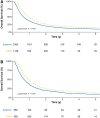Transarterial radioembolization versus systemic treatment for hepatocellular carcinoma with macrovascular invasion: Analysis of the US National Cancer Database
- PMID: 33837067
- PMCID: PMC8612185
- DOI: 10.2967/jnumed.121.261954
Transarterial radioembolization versus systemic treatment for hepatocellular carcinoma with macrovascular invasion: Analysis of the US National Cancer Database
Abstract
Background and Aims: Systemic therapy remains the recommended first-line treatment for hepatocellular carcinoma (HCC) with macrovascular invasion (MVI). Transarterial radioembolization (TARE) is a promising alternative treatment given superior quality of life. The aims of this study were to 1) characterize trends and correlates for TARE as first-line treatment of HCC patients with MVI in the US and 2) compare survival after TARE versus systemic therapy. Methods: We used the US National Cancer Database to identify patients with T3BN0M0 HCC during 2010-2017. We performed multivariable logistic regression to identify factors associated with use of TARE vs. systemic therapy and Cox proportional hazards regression to identify factors associated with overall survival. Results: Of 11,259 patients with T3BN0M0 HCC, 1454 (12.9%) and 3915 (34.7%) patients were treated with TARE and systemic therapy, respectively. The proportion of patients who received TARE increased from 13.0% in 2010 to 37.0% in 2017. Older age, White race, and receiving care at an academic cancer program were associated with receipt of TARE, while lack of insurance, higher MELD score, Charlson comorbidity Index ≥3, and Northeast region were associated with receipt of systemic therapy. TARE was associated with reduced mortality compared to systemic therapy (adjusted hazard ratio: 0.74, 95%CI: 0.68-0.80), with consistent results observed in propensity weighted analysis and across all examined subgroups. Conclusion: Use of TARE as first-line therapy for HCC with MVI has increased in the US. Patient characteristics, region, and medical center type affected the use of TARE. TARE was associated with reduced mortality compared to systemic therapy for HCC patients with MVI.
Keywords: Hepatology; Oncology: Liver; Radionuclide Therapy; hepatocellular carcinoma; macrovascular invasion; systemic treatment; transarterial radioembolization.
Copyright © 2021 by the Society of Nuclear Medicine and Molecular Imaging, Inc.
Figures




Similar articles
-
Transarterial Radioembolization for Hepatocellular Carcinoma with Major Vascular Invasion: A Nationwide Propensity Score-Matched Analysis with Target Trial Emulation.J Vasc Interv Radiol. 2021 Sep;32(9):1258-1266.e6. doi: 10.1016/j.jvir.2021.07.001. Epub 2021 Jul 7. J Vasc Interv Radiol. 2021. PMID: 34242775 Free PMC article.
-
Transarterial Radioembolization Versus Atezolizumab-Bevacizumab in Unresectable Hepatocellular Carcinoma: A Matching-Adjusted Indirect Comparison of Time to Deterioration in Quality of Life.Adv Ther. 2022 May;39(5):2035-2051. doi: 10.1007/s12325-022-02099-0. Epub 2022 Mar 12. Adv Ther. 2022. PMID: 35279814 Free PMC article.
-
Factors impacting survival after transarterial radioembolization in patients with hepatocellular carcinoma: Results from the prospective CIRT study.JHEP Rep. 2022 Nov 25;5(2):100633. doi: 10.1016/j.jhepr.2022.100633. eCollection 2023 Feb. JHEP Rep. 2022. PMID: 36593888 Free PMC article.
-
Transarterial chemoembolization versus transarterial radioembolization in hepatocellular carcinoma: optimization of selecting treatment modality.Hepatol Int. 2016 Nov;10(6):883-892. doi: 10.1007/s12072-016-9722-9. Epub 2016 Apr 28. Hepatol Int. 2016. PMID: 27126821 Review.
-
Economic evaluations of radioembolization with Itrium-90 microspheres in hepatocellular carcinoma: a systematic review.BMC Gastroenterol. 2022 Jul 2;22(1):326. doi: 10.1186/s12876-022-02396-6. BMC Gastroenterol. 2022. PMID: 35780112 Free PMC article.
Cited by
-
Transarterial Radioembolization Versus Systemic Treatment for Hepatocellular Carcinoma with Macrovascular Invasion: Analysis of the U.S. National Cancer Database.J Nucl Med. 2022 Jan;63(1):57-58. doi: 10.2967/jnumed.121.262917. Epub 2021 Dec 16. J Nucl Med. 2022. PMID: 34916247 Free PMC article. No abstract available.
-
Transarterial radioembolization versus tyrosine kinase inhibitor in hepatocellular carcinoma with portal vein thrombosis.Clin Mol Hepatol. 2023 Jul;29(3):763-778. doi: 10.3350/cmh.2023.0076. Epub 2023 May 30. Clin Mol Hepatol. 2023. PMID: 37254488 Free PMC article.
-
Price Analysis of Systemic Therapies and Transarterial Radioembolization for Treatment of Unresectable Hepatocellular Carcinoma.J Mark Access Health Policy. 2025 May 27;13(2):25. doi: 10.3390/jmahp13020025. eCollection 2025 Jun. J Mark Access Health Policy. 2025. PMID: 40568386 Free PMC article.
-
Prognostic nomogram for hepatocellular carcinoma with major vascular invasion: a population-based study from the SEER database and a Chinese cohort.Eur J Med Res. 2025 Sep 3;30(1):836. doi: 10.1186/s40001-025-03110-4. Eur J Med Res. 2025. PMID: 40903746 Free PMC article.
-
Role of interventional oncology in hepatocellular carcinoma: Future best practice beyond current guidelines.Br J Radiol. 2022 Sep 1;95(1138):20220379. doi: 10.1259/bjr.20220379. Epub 2022 Aug 4. Br J Radiol. 2022. PMID: 35867889 Free PMC article. Review.
References
-
- Bray F, Ferlay J, Soerjomataram I, Siegel RL, Torre LA, Jemal A. Global cancer statistics 2018: GLOBOCAN estimates of incidence and mortality worldwide for 36 cancers in 185 countries. CA Cancer J Clin. 2018;68:394–424. - PubMed
-
- Llovet JM, Ricci S, Mazzaferro V, et al. . Sorafenib in advanced hepatocellular carcinoma. N Engl J Med. 2008;359:378–390. - PubMed
-
- Cheng AL, Kang YK, Chen Z, et al. . Efficacy and safety of sorafenib in patients in the Asia-Pacific region with advanced hepatocellular carcinoma: a phase III randomised, double-blind, placebo-controlled trial. Lancet Oncol. 2009;10:25–34. - PubMed
-
- Finn RS, Qin S, Ikeda M, et al. . Atezolizumab plus bevacizumab in unresectable hepatocellular carcinoma. N Engl J Med. 2020;382:1894–1905. - PubMed
LinkOut - more resources
Full Text Sources
Other Literature Sources
